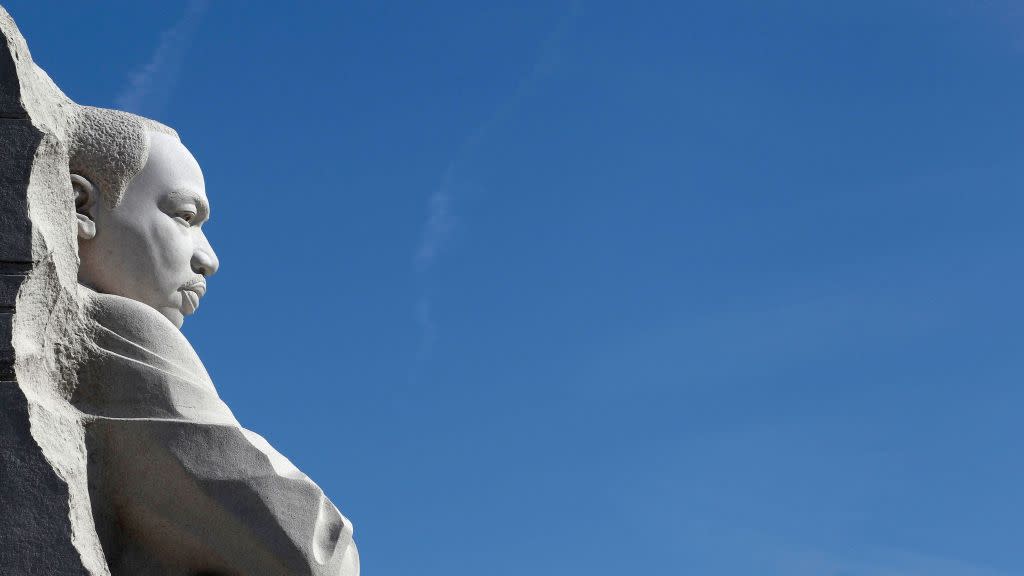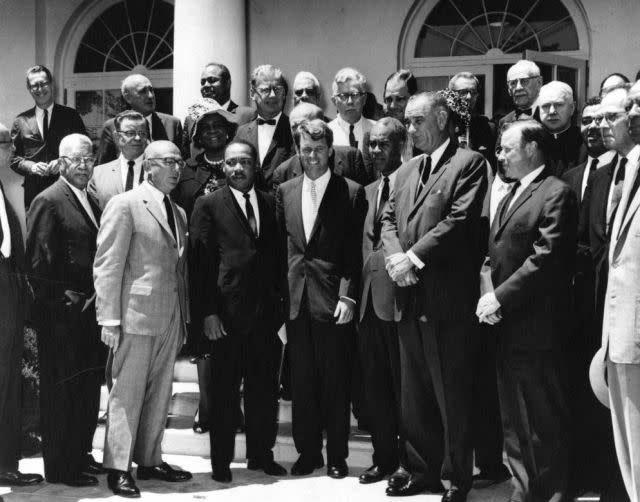Martin Luther King Jr.’s final, lesser-known campaign is more relevant than ever

In the weeks leading up to his assassination 50 years ago today, Dr. Martin Luther King, Jr. was preparing for his greatest demonstration yet. The Poor People’s Campaign—King’s coalition across racial groups, united in their fight to end poverty— aimed to recruit over 1 million people to occupy the National Mall. From Latino farmers’ rights activists to white Appalachian coal miners, King’s lesser-known dream sought to bring disparate communities together in the name of economic justice.
In planning the Poor People’s Campaign, King didn’t just set the stage for a new chapter of the civil rights movement. He provided a playbook for modern progressive politics, centered on the power of multicultural movements. Now, as the American working class includes more and more people of color—and Donald Trump tempts white voters with false promises—progressives can best honor King’s legacy by taking a page from the book he left behind.
The next chapter of the civil rights movement
Before his radical call for the Poor People’s Campaign, King’s fight against segregation and voter discrimination pushed the limits of racial discourse. Boycotts, sit-ins, protests and marches captivated and divided millions of Americans. Yet, despite dozens of arrests and countless death threats, King grew more determined to see his demands penned in national legislation.
Ten years after the catalyzing Montgomery Bus Boycott, King finally began to see the fruits of just labor. The landmark Civil Rights Act of 1964 and Voting Rights Act of 1965 yielded a bevy of long-overdue rights for black people, and cemented King’s legacy as America’s foremost civil rights leader.
But such an accolade, while much-deserved, is an incomplete representation of King’s complex aspirations. While addressing the Southern Christian Leadership Conference in 1967, King described the needed evolution of the civil rights movement: “I think it is necessary for us to realize that we have moved from the era of civil rights to the era of human rights…when we see that there must be a radical redistribution of economic and political power.”
Less than a year later—and two weeks before his death—King implored a small rally in Eutaw, Alabama to join his Poor People’s Campaign. “We fought here and all over from Selma right through the black belt of Alabama to get the right to vote,” King said. “Now we are fighting for the right to get the basic necessities of life.”
To fully transform American systems of oppression, King mobilized leaders across racial barriers. To fully transform American systems of oppression, King employed an oft-overlooked and incredibly forward looking strategy at the time: mobilizing leaders across racial barriers. He brought together renowned activists such as Myles Horton of Appalachia’s Highlander Center, Reies Tijerina of the Federal Alliance of New Mexico, as well as leaders of Asian and Native American descent, to devise a community-responsive path towards economic justice, and to address Washington as a unified front. A practiced organizer, King knew how multiracial movements could build strength in numbers. And in the mid-1960s, the nearly 20% of Americans living in poverty amounted to 40 million potential protesters and marchers.
King’s nascent, cross-community campaign was unprecedented in its demands: an Economic Bill of Rights for America’s poorest citizens, a $30 billion annual appropriation to fight against poverty, guaranteed income legislation, and the construction of 500,000 low-cost housing units each year until slums were eradicated. Proposals combining elements of universal basic income and government-guaranteed employment—topics of constant discussion today—were far ahead of their time. And as expected, King would not make such demands quietly.

Kennedy and King pictured in 1963.
The first step of the campaign’s multi-phase approach was the construction of “Resurrection City”—a tent-city strategically placed on the National Mall, teeming with America’s poor. In bringing such a spectacle to Washington’s doorstep, King would hold a mirror to America, and force legislators to reckon with their actions. When speaking on the Poor People’s Campaign, Dr. King described his grand vision: “We ought to come in mule carts, in old trucks, any kind of transportation people can get their hands on. People ought to come to Washington, sit down if necessary in the middle of the street and say, ‘We are here; we are poor; we don’t have any money; you have made us this way…and we’ve come to stay until you do something about it.’”
But following his assassination, and that of Senator Robert Kennedy, a fierce proponent of the Poor People’s Campaign, King’s grand vision amounted to little more than a dream deferred. Amidst a frantic search for assassin James Earl Ray, riots erupting across the country, and contention surrounding leadership, the Campaign came to a premature end.
Mobilizing a “majority-minority” working class
King’s untimely death derailed what could’ve been the greatest economic justice movement of our time. Since then, American inequality has grown without interruption. The average income of the bottom half of American earners has stagnated over the past three decades, and they now account for 12% of US wealth, while top 1% of American earners have tripled their average income, and account for over 40% of US wealth (pdf)—the worst gap since 1962, according to economist Edward N. Wolff.
And today, just as King propagated in his Poor People’s Campaign, government failures greatly contribute to wealth-loss across racial groups.
The greatest example of such failure is the Great Recession of 2007 to 2009—an ongoing cause of precipitous wealth-loss for low-income families. Between 2007 and 2016, the median wealth of white households grew to 10 times the wealth of black households, and sustained at eight times that of Hispanic households, according to Pew Research Center. To be black or Hispanic and working class in this country is to be forgotten.
But unlike the era of King, working class people of color have grown to a level that can no longer be ignored.
Unlike the era of King, working class people of color have grown to a level that can no longer be ignored. Long-term projections from the Bureau of Labor Statistics estimate that people of color will become the majority of the American working class by 2032 — 11 years before the Census Bureau predicts the US will become “majority-minority.” In response to these 2016 findings, one quote from the Economic Policy Institute (EPI), a nonpartisan think tank, directly reflects King’s rhetoric of multicultural movements: “Because the working class is increasingly people of color, raising working class living standards will require bridging racial and ethnic divides. The best way to advance policies to raise living standards for working people is for diverse groups to recognize that they share more in common than not.”
The EPI goes on to argue that coalescing working class Americans across racial lines can mean centralizing key goals, from increasing the minimum wage to reforming the immigration system to strengthening collective bargaining. Moreover, organizing working class people of color can have a tremendous effect on voting patterns. For example, in the last presidential election, non-white and Hispanic Americans were more likely to stay home than white voters. As a result, some argue that Hillary Clinton’s inability to turn out voters of color—especially young voters of color—may have contributed to her loss.
Organizing America’s poorest constituents also includes poor whites. And as gaps are shrinking within lower-income families across races, progressives have an opportunity to bring them closer to a new Poor People’s Campaign.
According to Pew Research Center, between 2007 and 2016, the gap between the median net worth of white middle lower-income families and that of black and Hispanic families shrunk by nearly half. Why? Given that there are more white homeowners than black, lower-income white families were more negatively affected by the housing crisis. But even as poor white families begin to bear more economic resemblance to poor black and Hispanic families, they still voted against their interest—best exemplified in their support for Donald Trump.
Upon pointing out how Trump handily won white voters across demographic categories, Ta-Nehisi Coates writes in the Atlantic that ”Trump assembled a broad white coalition that ran the gamut from Joe the Dishwasher to Joe the Plumber to Joe the Banker.” And yet, for Joe the Dishwasher and Joe the Plumber, Trump’s policies instead provide more harm than hope. In voting for Trump, low-income white voters transitively advocated to make their healthcare less affordable, Social Security less available, and over-time, increase their taxes.
In a country and world where immigration patterns and population-diversification threaten groups in power, Trump’s racist and xenophobic politics provided a means for white survival. In learning from King, progressives must refocus outreach to poor whites on economic populism, and illuminate truths hidden beneath deceptive conservative politics.
Finishing what King started
While many will use King’s death to celebrate the (ever-limited) progress of the civil rights movement, it is important to also remember its failures. King’s vision of a nation without poverty was never realized, but his legacy lives in on with his successors. Whether organizing against police brutality, destructive gun laws, or gender wage gaps, leaders who wish to commemorate King must always remember how marching feet move forward: together, or not at all.
Learn how to write for Quartz Ideas. We welcome your comments at ideas@qz.com.
Sign up for the Quartz Daily Brief, our free daily newsletter with the world’s most important and interesting news.
More stories from Quartz:

